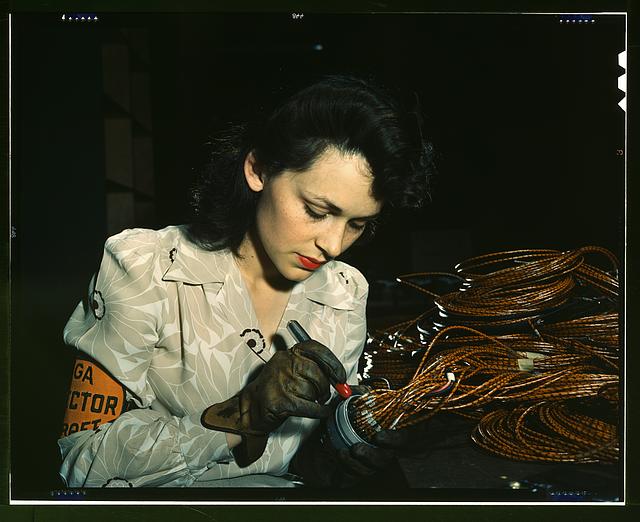The photograph titled “The Woman Aircraft Worker, Vega Aircraft Corporation, Burbank, Calif.” [1] taken by David Bransby in June 1942, captures a pivotal moment in American history, highlighting the significant roles women played during World War II. Before the war, the American workforce was predominantly male, and women were largely confined to domestic roles. However, the war catalyzed a dramatic shift in gender norms as industries faced critical labor shortages due to the draft. The government and industry leaders turned to women as a solution, launching widespread propaganda campaigns encouraging women to enter the workforce. One of the most iconic images of this effort was “Rosie the Riveter,” who symbolized strength and empowerment of women as they supported the war effort and challenged societal norms about gender roles in the workplace.

As detailed in “America: A Narrative History” by David Emory Shi, “The war marked a watershed in the status of women. With millions of men going into military service, the demand for civilian workers shook up old prejudices about gender roles in the workplace—and in the military.” [2] This shift created unprecedented opportunities for women in the workforce, fundamentally challenging traditional gender roles.
The Vega Aircraft Corporation, where this photograph was taken, was one of many factories that hired women to build aircraft for the military. Women became essential to maintaining production levels, and by 1943, they made up a significant portion of the workforce in such industries. Claudia Goldin, an American historian, highlights this shift in her article “The Role of World War II in the Rise of Women’s Employment,” stating that “many historians have concluded that World War II was that ‘watershed event’” [3] that catalyzed significant changes in women’s employment, as “the war led to increased labor requirements across the economy and to higher wages in general and specifically for women and other low-wage workers.” [3] Bransby’s photograph captures this new reality of the American Homefront. The woman in the image, focused intently on her work with gloved hands, embodies the shift in societal expectations. The armband labeled “Inspector” highlights the level of responsibility assigned to women, signifying how their roles evolved from mere support tasks to positions requiring technical skills and accountability.
The image further reflects the broader changes in women’s employment documented in Shi’s textbook, which notes, “More than 6 million women entered the civilian workforce during the war, an increase of more than 50 percent overall (100 percent in manufacturing alone).” [2] Many women welcomed the chance to escape traditional domestic roles and earn higher wages. As one female welder recalled, “It was the first time I had a chance to get out of the kitchen and work in industry and make a few bucks. This was something I had never dreamed would happen.” [2] The photograph by Bransby reinforces this sentiment by showing a woman in a position of skill and authority, challenging stereotypes about women’s capabilities in industrial roles.
Bransby’s composition emphasizes the woman’s concentration, with light focused on her face and hands, guiding the viewer’s attention to her work. The choice to photograph her in action, rather than in a posed manner, leads to authenticity of the image. It conveys a sense of purpose and highlights women as skilled workers during the war. Anderson, in her journal article “Teaching about Rosie the Riveter,” emphasizes that women’s participation in the workforce was essential, noting, “women made essential contributions to the successful prosecution of the war. The movement of millions of women into defense industry jobs enabled the economy to provide the essential tools of war to the military.” [4]
While the war created new opportunities for women, societal pressures and post-war policies often displaced them from these roles. Kossoudji and Dresser, in “Working Class Rosie’s: Women Industrial Workers During World War II,” argue that while some women left voluntarily, others were forced out by post-war policies favoring male employment. They explain, “The increase in supply was a patriotic rather than an economic act and the subsequent withdrawal was due to a resumption of personal preferences or a response to the pressures of a feminine ideology. The more recently conceived demand theory asserts that working class women responded to high industrial wages by changing occupations but were pushed out after the war as male managers and union leaders used seniority rules and institutional prerogative to return to an all-male workforce.” [5] This perspective aligns with Shi’s observation that “many men opposed women taking traditionally male jobs,”[2] emphasizing the resistance to women’s expanded roles despite their wartime contributions.
In conclusion, Bransby’s photograph serves as a testament to the transformative period during World War II when women’s labor became indispensable to the American economy. The articles, alongside the photograph, demonstrate how women’s work during the war reshaped societal norms and laid the groundwork for future gender equality movements. This image demonstrates not only the patriotic contributions of women but also their determination and skill, challenging long standing gender barriers and leaving an impact on American society.
All pictures obtained from The New York Public Library, Digital Collections.
[1] Bransby, David. “Woman Aircraft Worker, Vega Aircraft Corporation, Burbank, Calif. Library of Congress.” Library of Congress Prints and Photographs Division, July 1942. https://www.loc.gov/resource/fsac.1a34456/.
[2] Shi, David Emory and George Brown, Tindall. 2016. America: A Narrative History. New York, W.W. Norton & Company.
[3] Goldin, Claudia D. “The Role of World War II in the Rise of Women’s Employment.” The American Economic Review 81, no. 4 (1991): 741–56. http://www.jstor.org/stable/2006640.
[4] Anderson, Karen. “Teaching about Rosie the Riveter: The Role of Women during World War II.” OAH Magazine of History 3, no. 3/4 (1988): 35–37. http://www.jstor.org/stable/25162618.
[5] Kossoudji, Sherrie A., and Laura J. Dresser. “Working Class Rosies: Women Industrial Workers during World War II.” The Journal of Economic History 52, no. 2 (1992): 431–46. http://www.jstor.org/stable/2123119.
